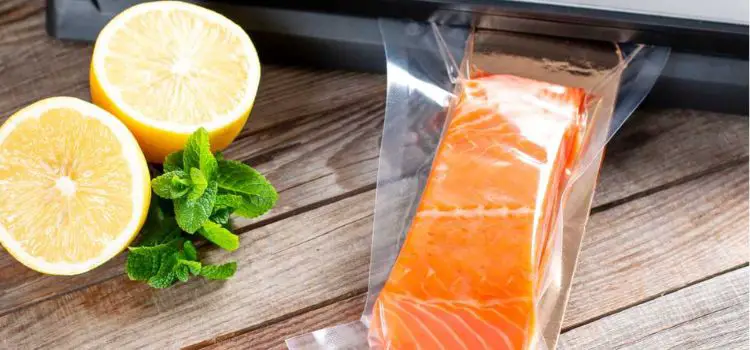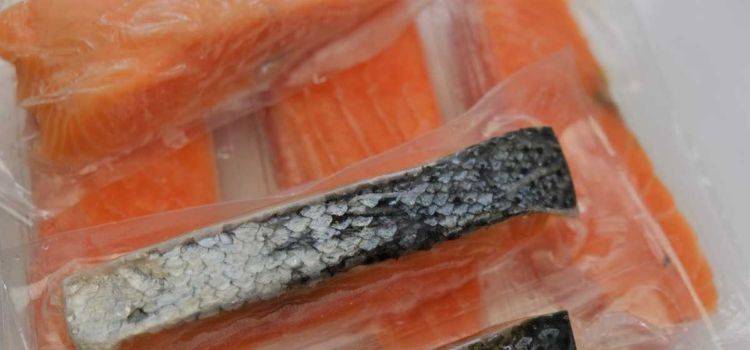As an Amazon Associate, I earn from qualifying purchases

When it comes to seafood, freshness is everything. Whether you’re a culinary enthusiast or just someone who enjoys a good fish fillet, understanding the nuances of seafood storage is crucial. Halibut, with its mild flavor and firm texture, is a favorite among many. However, preserving its quality over time requires more than just placing it in the freezer; it demands a method that ensures prolonged freshness and flavor retention. This is where vacuum sealing comes into play.
Vacuum sealing, combined with freezing, is a highly effective method for preserving seafood. This technique involves removing air from the packaging, which helps maintain the fish’s quality and extends its shelf life significantly. But how long can you expect vacuum-sealed halibut to remain top-notch in your freezer? Let’s dive deeper into the science and art of seafood preservation to find out.
Benefits of Vacuum Sealing
1. Preserves Flavor and Texture:
Vacuum sealing locks in moisture, preventing halibut and other seafood from drying out. This method ensures that the delicate texture and rich flavor of the fish are maintained, making every meal enjoyable.
2. Prevents Freezer Burn:
By eliminating air exposure, vacuum sealing helps prevent freezer burn, which causes dehydration and oxidation. This not only preserves the fish’s appearance but also ensures its taste and nutritional value remain intact.
3. Reduces Waste and Spoilage:
Vacuum sealing allows you to buy seafood in bulk and store it for longer periods without fear of spoilage. This efficiency reduces food waste, making it both an economically and environmentally friendly choice.
Shelf Life of Vacuum-Sealed Halibut in the Freezer
When stored under optimal conditions, vacuum-sealed halibut can last in the freezer for a significant period, retaining its quality for up to 18 months. This is a stark contrast to non-vacuum-sealed fish, which typically lasts only three to six months before quality begins to degrade.
The extended shelf life is due to the airtight environment created by vacuum sealing, which hinders the growth of bacteria and slows down the oxidation process. Compared to traditional freezing methods, vacuum sealing ensures that the fish remains as close to fresh as possible for a much longer time.
However, it’s important to note that while vacuum sealing prolongs shelf life, it does not make the fish immune to all spoilage factors. Proper handling and storage practices are still essential to maximize the benefits of this preservation technique.
Factors Affecting Shelf Life

- Temperature Control: Maintaining a consistent freezing temperature is essential for the longevity of vacuum-sealed halibut. The ideal temperature is at or below 0°F (-18°C). Any fluctuations can lead to partial thawing and refreezing, which may compromise both the texture and safety of the fish.
- Quality of Sealing: The effectiveness of the vacuum seal significantly impacts the fish’s preservation. An improper seal can allow air and moisture to seep in, undermining the benefits of vacuum sealing. It’s vital to ensure the vacuum-sealer is functioning properly, and that the bag is sealed tightly, free from any punctures or leaks.
- Initial Freshness: The freshness of the halibut before sealing is a critical factor. Always start with fresh fish; otherwise, vacuum sealing will only preserve spoilage rather than extending shelf life.
- Proper Storage Practices: Where and how you store the halibut in the freezer matters. Placing the fish at the back of the freezer, where temperatures remain stable, can significantly enhance its shelf life.
Tips for Ensuring Maximum Freshness
To get the most out of your vacuum-sealed halibut, here are some practical tips:
- Select Fresh Fish: Always start with the freshest halibut possible. The fresher the fish, the better it will taste after being stored.
- Use Quality Vacuum-Sealing Equipment: Invest in a good-quality vacuum sealer. A reliable machine ensures a proper seal and prevents air from entering the package.
- Proper Freezing Techniques: Freeze the fish as quickly as possible after sealing. Rapid freezing helps preserve the texture and flavor better than a slow freeze.
- Thawing Guidelines: When it’s time to enjoy your halibut, thaw it in the refrigerator rather than at room temperature. This slow and controlled thawing process helps maintain quality.
- Check for Signs of Spoilage: Even with the best practices, it’s important to check the fish for any signs of spoilage before consuming. Discoloration, off smells, or a slimy texture are indicators that the fish may not be safe to eat.
- Label and Rotate Stock: Always label your vacuum-sealed packages with the date they were sealed and rotate your stock, using the oldest first to ensure nothing is forgotten in the back of the freezer.
Conclusion
Vacuum sealing offers a reliable and efficient way to extend the shelf life of halibut, making it possible to enjoy this delicious fish long after purchase. By understanding the benefits of vacuum sealing and implementing best practices for freezing and storage, you can ensure that your halibut remains fresh, flavorful, and safe to eat for up to 18 months.
The key to successful seafood storage lies in attention to detail and a commitment to maintaining quality at every step. With these guidelines, you can confidently stock up on halibut and enjoy its delectable taste whenever the craving strikes.
FAQ
How long is vacuum sealed fish good for in the freezer?
Vacuum-sealed fish can last up to 18 months in the freezer when stored under optimal conditions. This method minimizes air exposure, preventing freezer burn and preserving flavor and texture. However, maintaining a consistent temperature of 0°F (-18°C) or below is crucial for maximum shelf life.
How long does vacuum sealed last in the freezer?
Generally, vacuum-sealed foods can last significantly longer in the freezer compared to non-sealed items. Most vacuum-sealed foods maintain quality for 1-3 years, while traditional methods may only last 6-12 months. This extended shelf life depends on consistent storage conditions and proper sealing techniques.
How to tell if vacuum sealed fish is bad?
To determine if vacuum-sealed fish is spoiled, check for changes in color, such as a dull or grayish hue, and any unpleasant odors. A slimy texture or any signs of mold are clear indicators of spoilage. Always smell and visually inspect the fish before consuming.
As an Amazon Associate, I earn from qualifying purchases